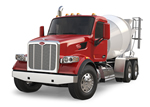Manufacturer continues the evolution of its mixer- and dump-ready Model 567 with the introduction of a set-forward front axle (SFFA) version, which debuted at World of Concrete 2015 with production scheduled to begin in June.
“The SFFA lets customers maximize payloads while helping meet state and federal bridge law requirements. The Model 567 is a low-weight leader and this new configuration will let customers take full advantage of that through optimized weight distribution,” says Peterbilt Assistant General Manager of Sales & Marketing Robert Woodall.
Like the charter set-back axle version premiering two years ago, the Model 567 SFFA is available in 115- and 121-in. bumper-to-back-of-cab lengths, with bumper to front axle distances of 29 inches and 31 inches, respectively. The dimensions are carefully engineered to maximize maneuverability while providing the ideal wheelbase to comply with bridge law requirements, Peterbilt engineers note.
“The new axle position builds on the Model 567’s already exceptional versatility, helping customers across a wide range of applications reach higher levels of performance, productivity, and profitability,” Woodall contends. “The Model 567 broke new ground for visibility, maneuverability, and durability. Reception has been overwhelmingly positive and the new SFFA configuration gives our customers more choices than ever to meet their jobsite requirements and business goals.”
Both the set-forward and set-back front axle Model 567 configurations are standard with the Paccar MX-13 engine, rated at up to 500 hp and 1,850 lb.-ft. of torque. Lightweight and durable, an all-aluminum cab sports strategically positioned steel reinforcements. Durability is further improved with a Metton hood that is highly resilient and can absorb many impacts that would shatter or crack other materials. The vehicle also features Peterbilt’s signature stainless steel oval mesh grille and surround; the hood pivot system has a protection function that directs energy around the cooling module in the event of an impact.
The Model 567’s chassis is designed to maximize strength while minimizing weight for increased payload capacity. The chassis is 10–15 percent stiffer than comparable models for improved maneuverability, ride and handling. Clear frame rails facilitate ease of installation for various bodies, auxiliary axles and hydraulic tanks.
Maximum forward visibility is achieved through a panoramic windshield, integrated locaters in the cab structure affording time-efficient field repairs. The forward lighting system improves down-road visibility and reduces driver fatigue. The headlamps feature projector module low beams, which have a 2,000-hour lifecycle, and complex reflector high beams. — www.peterbilt.com
ALL-WHEEL DRIVE FEATURE
 |
| As noted in March (“World of Concrete back in a big way,” page 8), Peterbilt Motors parked the premier 567 SFFA in the Las Vegas Convention Center, ahead of delivery to the Cemex USA fleet. |
The Peterbilt Model 567 suits a full range of heavy- and severe-duty applications. A new all-wheel drive option means the company’s flagship vocational truck is ready for what engineers characterize as even tougher jobsites and more extreme terrains. “[It] will help customers go off-road in tough conditions with ample traction, power and maneuverability they can rely on,” affirms Peterbilt Assistant General Manager of Sales and Marketing Robert Woodall.
All-wheel drive is available for the Model 567 in a set-back front axle configuration. It includes the Marmon-Herrington MT-22H front drive axle rated at 22,000 lb. and the Dana Spicer DS4636 drive axle rated at 46,000 lb. It can be ordered with a range of auxiliary components, including transfer cases, to meet the full array of customer needs. If customers prefer, the drive axle can be used in place of the transfer case.
